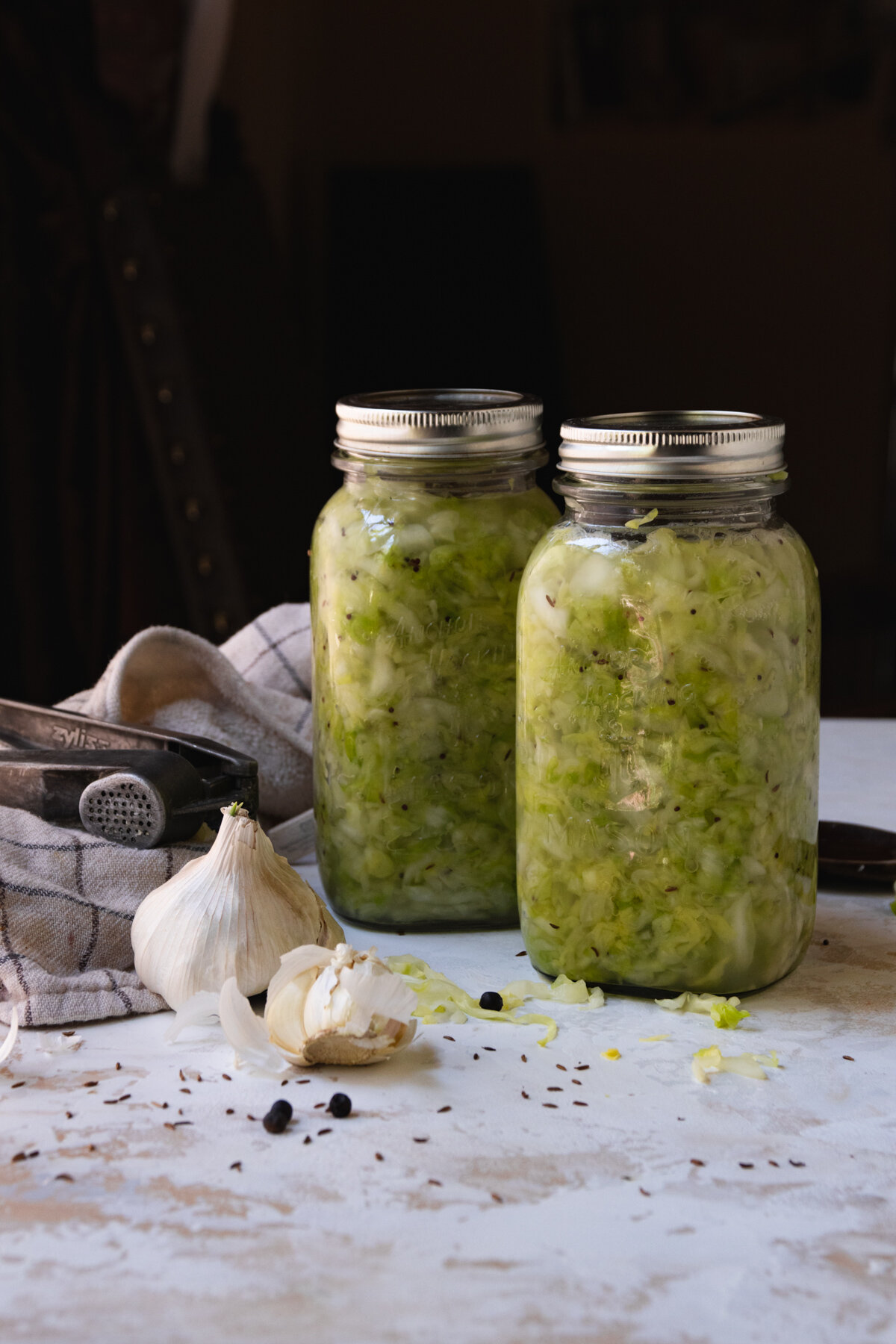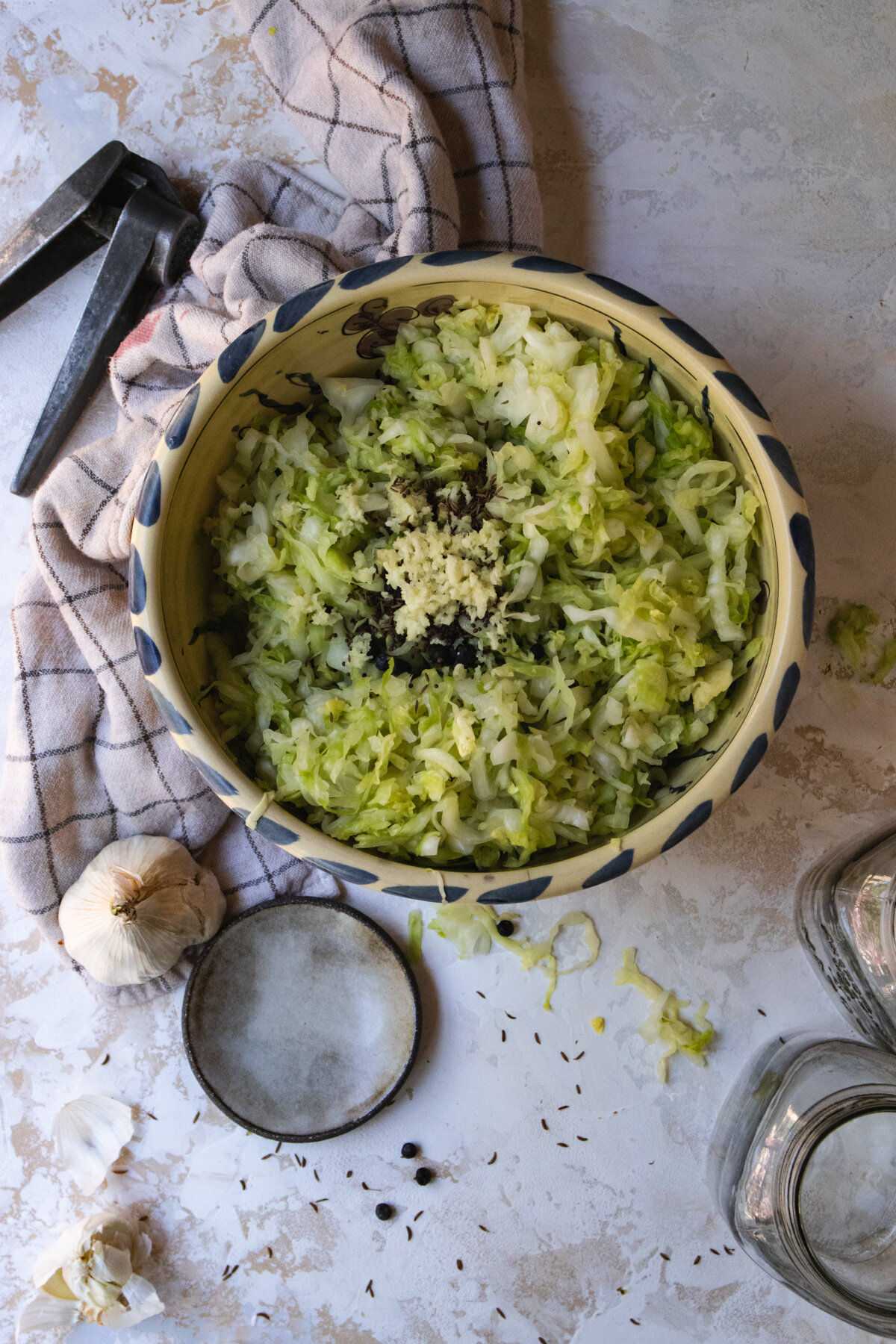Homemade Sauerkraut + A bonus recipe for Bratwurst Sandwiches
During seasons of abundant gardens and farmers' markets, preserving and canning are how I savor the flavors of the season. Stone fruit is around every corner, and our plum tree yielded the best harvest in years. Plums turned into cake and jam, and tomatoes soon to be enjoyed fresh while some squirreled away to be frozen and enjoyed in winter. And this month, I delved into the process of fermentation.
This sauerkraut recipe is woodsy and aromatic, with juniper berries and caraway seeds that taste softly of pine and anise-like licorice. Reminiscent of winter spices, yet mild and close enough to tradition that it can be served with dishes both sweet and savory. A little stronger and more flavorful than traditional salt-brined sauerkraut, I wanted my sauerkraut to be satisfying and aromatic.
My first batch came out flavorful but overly potent - a little bit of each spice goes a long way in fermentation. In a way though, it was everything I was looking for in sauerkraut. Strong and sour and bursting with aromatics, though household members advised that I rework the spice ratios. Suffice to say, I finished the jar by myself and set off on another round of recipe testing.
This final recipe is the result of a month of testing alongside many delicious sauerkraut centered meals. Made in small batches, this recipe yields two 32 oz jars of sauerkraut, which is perfect for enjoying one now and saving the other for seasons down the road.
On Fermentation
During the first week of fermentation, the sauerkraut will be at it's most potent. Don't worry! The first week yields all sorts of good bacteria and lactic acid fermentation, which will later mellow and provide the sour flavor. Especially at this funky stage, I recommend keeping your jar on a baking sheet or plate, as the gases may cause the brine to overflow.
Every couple of days, use a wooden spoon to press down the cabbage so that it is fully submerged in the brine, leaving enough space between the cabbage and lid. Patting down the sauerkraut helps lessen gas build-up, which will prevent any sort of burst upon opening. Be careful - and check on your sauerkraut daily!
After the first week, the sauerkraut will be strong, but on it's way to becoming delicious mellow sauerkraut. At this stage, start tasting the sauerkraut each day. There is no firm timeline for when sauerkraut is ready; it all depends on your personal preference. For me, this recipe is ready to eat after 2 weeks, though variables like jar size, environmental bacteria, and room temperature all contribute to the fermentation process. Once you think it's ready, enjoy with a meal of bratwurst.
Keep tightly sealed in a clean jar and refrigerate once opened.
One of our last outings in March was to our local German deli to pick up some bockwurst and bratwurst to freeze for the coming months. We served my sauerkraut in sandwiches, made with demi-baguettes, whole grain mustard, and bratwurst braised with onions. It is simple and easy to assemble, made special with homemade sauerkraut. As a bonus, I've written out the recipe below for you to enjoy!
Homemade Sauerkraut
This German-style sauerkraut is woodsy and aromatic, with juniper berries and caraway seeds that taste softly of pine and anise-like licorice. Reminiscent of winter spices, yet mild and traditionally flavored, it spans the seasons and compliments the most savory of dishes.
Ingredients
4 lbs green cabbage, thinly sliced
2 tablespoon salt
3 cloves of garlic, minced
1 teaspoon mustard seeds
1 teaspoon caraway seeds
10-12 juniper berries
Note: *If you would like to make a smaller recipe, the standard ratio for salt to cabbage is ~1/2 tablespoon / 10 grams salt for every lb of cabbage.
Method
Preparation: Before starting, make sure your jars are fully sanitized and ready to fill. No heat sealing is required, but ensuring a clean environment will help the fermentation process!
Prepare the sliced cabbage in a large mixing bowl. Gradually begin sprinkling in the salt, working it in with your hands. Thoroughly mix, massage and squeeze the cabbage until the the salt is fully incorporated and the cabbage begins to soften and produce a briny liquid. Let sit for 30 minutes, then mix in the garlic, caraway, mustard seeds, and juniper berries.
Pack the cabbage into the jars so that it is fully submerged in the brine, leaving at least a 1/2 inch of space between the cabbage and the lid. Partially screw on the cap and store in a cool, dry place away from direct sunlight. In order to avoid any spillage from overfilled jars or especially active fermentation, keep the jars on a plate or baking sheet.
Each day, check on your sauerkraut! Press down the cabbage with a wooden spoon to keep it submerged in brine.
Fermentation can be a wild and exciting process, which means the chemistry of your sauerkraut will be changing day to day. The bacteria found in sauerkraut is amazingly diverse and most active and changing in this initial fermentation. This first week is especially strong and funky, and I wouldn’t recommend tasting until the 7th day. Thought your sauerkraut isn’t quite at it’s peak, it’s good to check out the smell and appearance as well. Especially potent or sour smells are common - these will later develop into mellow, pleasantly sour flavors. Foam, white liquid, and surfacing bubbles are common changes, but all positive signs of fermentation! If you happen to see any mold forming on the surface, make sure to skim it off the top and remove any cabbage in contact.
Just let the fermentation process take hold.
During week 2, continue pressing down the cabbage daily. Now you can start tasting!
There is no firm timeline for when sauerkraut is ready; it all depends on your personal preference. For me, this recipe is ready to eat after 2 weeks, though variables like jar size*, environmental bacteria, and room temperature all contribute to the fermentation process.
Optional: Transfer one jar into a freshly sanitized jar and tightly seal. Store at room temperature for up to 2 months. Refrigerate after opening.
*Smaller jars will greatly speed up the fermentation timeline, so starting checking after 3-4 days if using anything smaller than 32 oz.
Sauerkraut, Onion + Bratwurst Sandwiches
Ingredients
4 bratwurst sausages
1 tbsp olive oil
1 red onion, thinly sliced
4 sandwich rolls or demi-baguettes, sliced partially in half
Whole grain mustard
Method
In a large pan, brown the bratwurst in the olive oil over medium heat. Reduce the heat and add the sliced red onion, slowly cooking until the bratwurst is cooked through and the onions are soft and caramelized.
Serve the sausage and onions in warm baguettes with whole grain mustard and sauerkraut on top.








